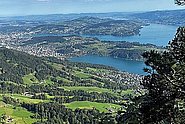
Quality and Value of the Landscape ¶
What makes us like certain landscapes better than others? We examine which landscape features are important to people. This helps to maintain the quality of the landscape despite its constant change.
Contents ¶
Landscapes are characterised by elements and features such as open spaces and green spaces or typical regional settlement and management forms. People perceive these and evaluate them; the (perceived) landscape quality results from this. We look into how people perceive the landscape and what elements and features are important to them. Because landscapes are constantly changing, the following questions arise: how do landscape features change? What are the consequences for landscape quality? How can important landscape features and landscape quality be maintained in the long term? Our research provides answers to such questions and thus provides the decision-making basis for landscape policy.
Values and Performance of Landscapes ¶
The values of landscapes are closely linked to their features. There are many of these, as landscapes have ecological, aesthetic, cultural, economic and emotional values. Identifying and evaluating these makes up a significant part of the WSL's landscape research. For example, we examine how nature and landscape can be economically assessed and what factors influence the aesthetic value of living spaces and landscapes.
The value of landscapes for people and society can be expressed through landscape benefits. These include, for example, local recreation and leisure, protection from natural hazards, and the production of renewable energies. For various spatial levels, we look at which benefits landscapes provide to the community. To this end, we are developing methods for mapping out benefits and predicting future spatial distributions, for example local recreation and leisure. Our research has made it easier to integrate this into practical spatial planning.






